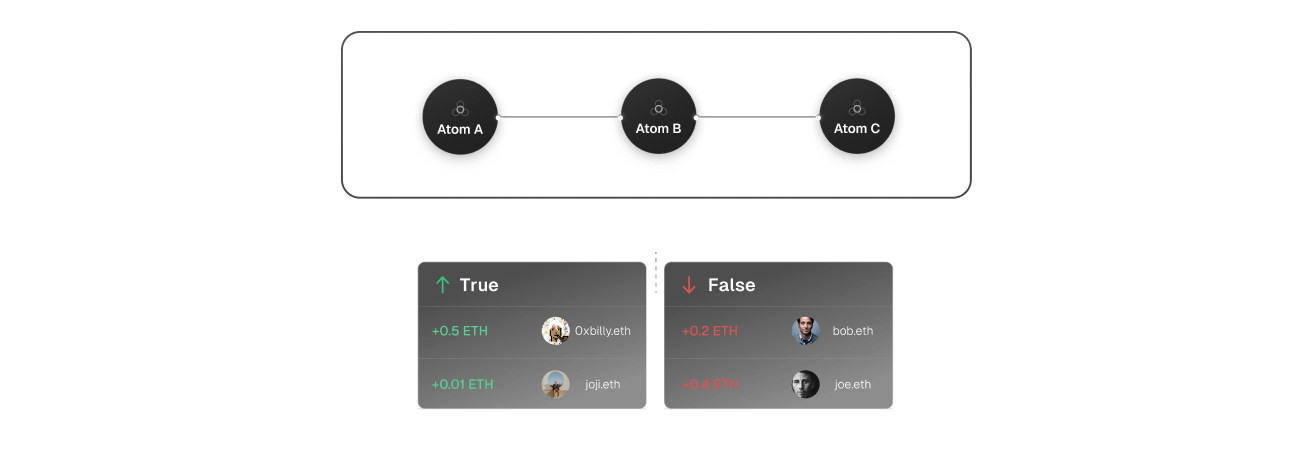Signal
Signal, in the context of Intuition, refers to any action or indication that expresses intent, belief, or support. Signals can be classified into three broad categories: explicit signal, implicit signal, and transitive signal. These signals play a crucial role in interpreting user behavior, beliefs, and preferences within the system.
Types of Signal
Explicit Signal
A clear, intentional action taken by a user to express support, belief, or intent. These actions are directly observable and often involve a formal mechanism within the system.
Example: A proof of humanity attestation from Worldcoin is an explicit signal that Worldcoin believes the entity to be human.
Implicit Signal
Indirect or inferred indications of support, belief, or intent. This signal is not always directly observable and are often deduced from user behavior or patterns.
Example: The frequency and context of user interactions with certain data points can imply their support or belief.
Transitive Signal
Trust or belief that is passed along through a network of relationships. This type of signal leverages the idea that trust can be extended through connections.
Example: If User A attests to something about User B, and User C trusts User A, then User C extends trust to User B.
Signal in Intuition
Though all systems naturally generate implicit signal, explicit signal in Intuition is expressed in a novel format that enables and incentivizes the creation of many-to-one, non-deterministic attestations.
Key Innovation
In Intuition, these semantic statements do not have a single 'issuer' - instead, anyone/anything can signal support or rejection of any existing statement/attestation at any point in time. This decoupling of information from 'who is presently expressing/supporting that information' introduces the ability to accommodate many-to-one attestations, making the data significantly more usable - especially for more complex use cases that involve the concept of transitive signal, such as reputation.

To accomplish this, the Intuition system enables users to maintain positions on Atoms and Triples, interpreting these positions as explicit signal from the user. This mechanism can be implemented using tokens or other accounting systems that have the ability to track user balances over time across an arbitrarily large number of entities.
Atom Signal
Within the Intuition framework, users signal their belief in the relevance of an Atom by adjusting their balance on that Atom. This balance can be increased or decreased arbitrarily.

Balance Interpretation
Zero Balance
Implies no signal, indicating neutral stance on the Atom's relevance.
Positive Balance
Indicates a degree of belief in the Atom's relevance, with higher balances showing stronger belief.
Negative Balance
May be used to explicitly signal the irrelevance of an Atom (if supported by the implementation).
This mechanism is economically driven: users earn fees proportional to their ownership stake in an Atom as other users interact with it. Thus, if a user deems an Atom relevant, they are incentivized to signal its relevance to receive these rewards.
Triple Signal
In the Intuition framework, users signal their belief in both the relevance and truthfulness of a Triple by modifying their balance on that Triple. Triple balances can be any integer, allowing for a nuanced expression of belief.
Triple Balance System
Zero Balance
Indicates no signal, neutral stance on the Triple.
Positive Balance
Affirms the Triple, indicating it is considered true and relevant.
Negative Balance
Signals rejection of the Triple, indicating it is considered false and relevant.
Example: Trustworthiness Triple
Example: "[Vitalik][is][trustworthy]"
For example, with a Triple asserting "[Vitalik][is] [trustworthy]," users would express their belief in its truthfulness, and the relevancy of this truthfulness, by increasing their balance on the affirmative side of the Triple, or signal disbelief by decreasing their balance into the negative. This mechanism allows for nuanced expressions of trust and belief within the decentralized ecosystem.
Positive Balance
Believes Vitalik is trustworthy
Negative Balance
Believes Vitalik is not trustworthy
Zero Balance
No opinion on Vitalik's trustworthiness

This mechanism allows for nuanced expressions of trust and belief within the decentralized ecosystem.
Advanced Applications
This system enables each "statement" to exist in different states based on who is affirming or rejecting it. To illustrate the power of this approach, consider the example of building a decentralized list of followers.
Traditional vs Intuition Model
Traditional One-to-One
If a user had 1,000 followers, there would be 1,000 separate "following" claims. Most of this data would be redundant, as the "following Y" part would remain constant across all claims.
Intuition Model
A single Triple representing "I am following Y." Users adjust their balances on this statement to express their stance. To see all followers of Y, examine the Triple and identify who has positive balances.
Furthermore, the ability to adjust balances allows for a more nuanced expression of preferences. In the context of a 'follow' functionality, instead of a flat follow list where all followers are treated equally, users could explicitly signal varying levels of interest or endorsement.
Nuanced Preferences
By increasing their balance on the followers they value more, users can effectively rank their follow list. This means that someone could show a stronger preference for certain individuals or entities by staking more tokens on their affirmations, creating a dynamic and tiered system of trust and preference.
This not only enhances the granularity of data but also provides richer insights into user preferences and social dynamics within the network.
Next Steps
Now that you understand Signal, explore:
- Fees & Rewards - Learn about the economic incentives
- Capturing Signal - Advanced techniques for signal capture
- State Interpretations - Understand how signal is interpreted